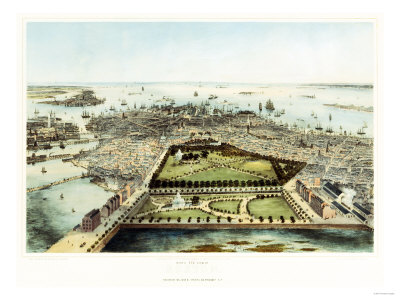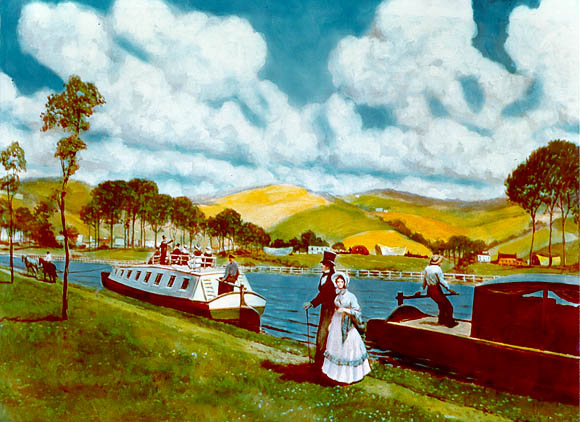 Urban expansion in America from 1800 to 1865 was impressive. There was an intense competition of urbanization among many cities. Transportation improvement, for example, played a big role in the development of both New York City and Chicago. Like New York City, Chicago benefitted from the establishment of Erie Canal. The 363-mile canal, running west from Hudson River at Albany to Lake Erie at Buffalo, completed the job of linking the Atlantic Ocean to the Great Lakes. The connection among Erie Canal, and Lakes Erie, Huron, and Michigan made it possible for Chicago to extend its trade with other regions despite its location in the interior of the continent. Allowing a new route of water travel, the canal largely reduced the shipping costs. Due to this advantage, Chicago emerged as one of the largest lake ports in the region. New York City also benefitted from Erie Canal since the canal extended its trade from New York State to the entire Great Lakes System. Thanks to this transportation improvement, the economy of New York City grew even more rapidly, and manufacturing was spread out.
Urban expansion in America from 1800 to 1865 was impressive. There was an intense competition of urbanization among many cities. Transportation improvement, for example, played a big role in the development of both New York City and Chicago. Like New York City, Chicago benefitted from the establishment of Erie Canal. The 363-mile canal, running west from Hudson River at Albany to Lake Erie at Buffalo, completed the job of linking the Atlantic Ocean to the Great Lakes. The connection among Erie Canal, and Lakes Erie, Huron, and Michigan made it possible for Chicago to extend its trade with other regions despite its location in the interior of the continent. Allowing a new route of water travel, the canal largely reduced the shipping costs. Due to this advantage, Chicago emerged as one of the largest lake ports in the region. New York City also benefitted from Erie Canal since the canal extended its trade from New York State to the entire Great Lakes System. Thanks to this transportation improvement, the economy of New York City grew even more rapidly, and manufacturing was spread out.
However, unlike New York City, Chicago also benefitted from another form of transportation improvement—a web of railroad. It is worth pointing out that building railroad tracks were cheaper than building canals, and they don’t freeze in the winter. Railroad could also run through some tough areas. Thus, during the 1850s, the railroad system grew to serve the entire Illinois State. At the same time, more than 30,000 miles railroad was built in America. The complexity of the rail system allowed transporting products easier. The dependence of water transportation no longer existed, and railroad system immediately dominated the Midwest commercial transportation. At the heart of the Midwest, the location of Chicago won over the location of New York City. As a result, Chicago emerged more quickly, with its population growing from hundreds in the 1830s to more than 109,260 in the 1860s, making it one of the major cities of the nation.(38-39, Chudacoff)

 Urban expansion in America from 1800 to 1865 was impressive. There was an intense competition of urbanization among many cities. Transportation improvement, for example, played a big role in the development of both New York City and Chicago. Like New York City, Chicago benefitted from the establishment of Erie Canal. The 363-mile canal, running west from Hudson River at Albany to Lake Erie at Buffalo, completed the job of linking the Atlantic Ocean to the Great Lakes. The connection among Erie Canal, and Lakes Erie, Huron, and Michigan made it possible for Chicago to extend its trade with other regions despite its location in the interior of the continent. Allowing a new route of water travel, the canal largely reduced the shipping costs. Due to this advantage, Chicago emerged as one of the largest lake ports in the region. New York City also benefitted from Erie Canal since the canal extended its trade from New York State to the entire Great Lakes System. Thanks to this transportation improvement, the economy of New York City grew even more rapidly, and manufacturing was spread out.
Urban expansion in America from 1800 to 1865 was impressive. There was an intense competition of urbanization among many cities. Transportation improvement, for example, played a big role in the development of both New York City and Chicago. Like New York City, Chicago benefitted from the establishment of Erie Canal. The 363-mile canal, running west from Hudson River at Albany to Lake Erie at Buffalo, completed the job of linking the Atlantic Ocean to the Great Lakes. The connection among Erie Canal, and Lakes Erie, Huron, and Michigan made it possible for Chicago to extend its trade with other regions despite its location in the interior of the continent. Allowing a new route of water travel, the canal largely reduced the shipping costs. Due to this advantage, Chicago emerged as one of the largest lake ports in the region. New York City also benefitted from Erie Canal since the canal extended its trade from New York State to the entire Great Lakes System. Thanks to this transportation improvement, the economy of New York City grew even more rapidly, and manufacturing was spread out.










 The Barnum’s American Museum was the popular attraction in 19th century New York City. P.T.Barnum purchased this museum from John Scudder in 1841. By 1850 he had greatly influence on the mid-19th century popular culture. The museum was burned down at the end of the Civil War. In this lost museum, you can find exotic animals from around the world, a number of “human curiosities” and many different wonders. Barnum used different kinds of innovative ways to dazzle the audiences. The museum displayed automata that imitated human and animal behavior and lantern slide shows, cosmoramas, and panoramas that presented images in new ways. The museum foreshadowed the commercial culture and pop culture in the United States. The museum is not only a place for entertainment, it also promoted the education on natural science in its animal exhibition, included historical context in its paintings and wax figures, and temperance reform and Shakespear dramas in its “Lecture Room”. Through adding educational value into its exhibitions, Barnum avoided to offend the religiously inclined. The Barnum’s American Museum was a single place where the people from different classes, immigrant, tourists, and residents, men and women could gather. It reflected the diversity of the American population at that time. However, in order to reinforce the white identities of museum patrons, african americans were only allowed in the museum on a limited basis. It was a key site for the antebellum articulation of whiteness. In addition, many of the exhibits in the museum reflected the emerging political and social crises that led to secession and Civil War.
The Barnum’s American Museum was the popular attraction in 19th century New York City. P.T.Barnum purchased this museum from John Scudder in 1841. By 1850 he had greatly influence on the mid-19th century popular culture. The museum was burned down at the end of the Civil War. In this lost museum, you can find exotic animals from around the world, a number of “human curiosities” and many different wonders. Barnum used different kinds of innovative ways to dazzle the audiences. The museum displayed automata that imitated human and animal behavior and lantern slide shows, cosmoramas, and panoramas that presented images in new ways. The museum foreshadowed the commercial culture and pop culture in the United States. The museum is not only a place for entertainment, it also promoted the education on natural science in its animal exhibition, included historical context in its paintings and wax figures, and temperance reform and Shakespear dramas in its “Lecture Room”. Through adding educational value into its exhibitions, Barnum avoided to offend the religiously inclined. The Barnum’s American Museum was a single place where the people from different classes, immigrant, tourists, and residents, men and women could gather. It reflected the diversity of the American population at that time. However, in order to reinforce the white identities of museum patrons, african americans were only allowed in the museum on a limited basis. It was a key site for the antebellum articulation of whiteness. In addition, many of the exhibits in the museum reflected the emerging political and social crises that led to secession and Civil War.



 The tour of The Lost Museum was a very informative experience. I didn’t really know what to expect when I entered, but as I progressed and explored all the three floors I came out with a decent sense of the history of New York City. It wasn’t really like the museums nowadays, but it had a very good feel of what a typical 19th century museum would be like.
The tour of The Lost Museum was a very informative experience. I didn’t really know what to expect when I entered, but as I progressed and explored all the three floors I came out with a decent sense of the history of New York City. It wasn’t really like the museums nowadays, but it had a very good feel of what a typical 19th century museum would be like. In addition to the presentation on the fires in NYC, I thought the portrayal of what entertainment was like in NYC in the past was very interesting too. Nowadays, entertainment means tv, movies, sports, etc. In the 1700 and 1800s, I learned that entertainment for them mainly were plays that acted out domestic dramas. Many people went and watched people perform live on stage for entertainment, for example “The Drunkard or the Fallen Saved.”
In addition to the presentation on the fires in NYC, I thought the portrayal of what entertainment was like in NYC in the past was very interesting too. Nowadays, entertainment means tv, movies, sports, etc. In the 1700 and 1800s, I learned that entertainment for them mainly were plays that acted out domestic dramas. Many people went and watched people perform live on stage for entertainment, for example “The Drunkard or the Fallen Saved.”